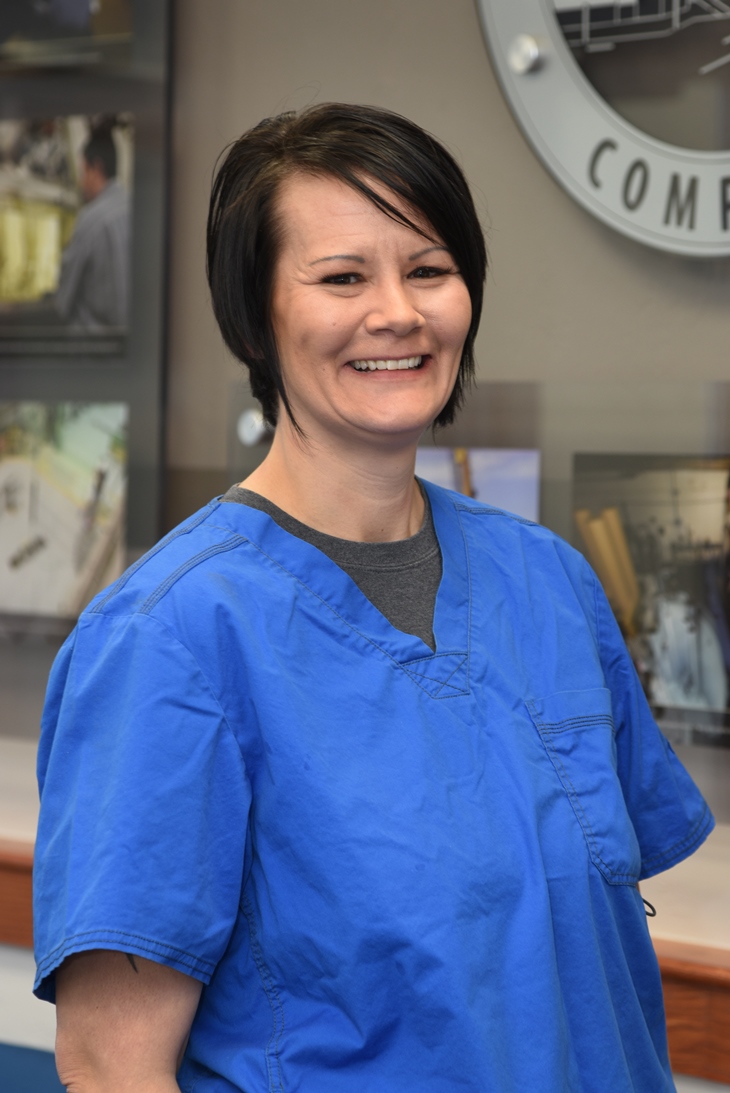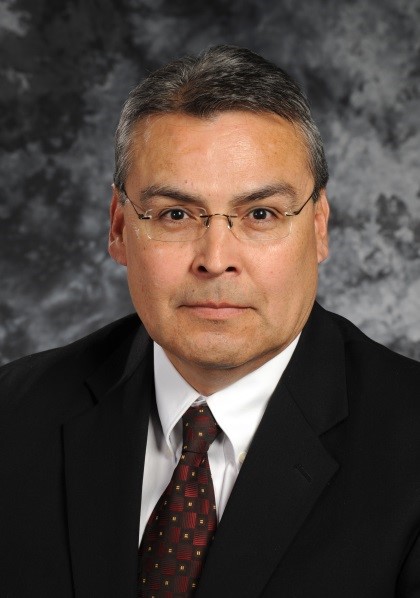Melonie Larsen and Rod Bitsoi have something in common: they both share a common Native American ancestor: Joseph Henry Bitsoi. He is Larsen’s grandfather and Bitsoi’s father.
Larsen is a health physics technician at Idaho National Laboratory’s Materials and Fuels Complex (MFC). Bitsoi is a sitewide facilities and operations director with more than 25 years on the job. Both trace their roots to the Navajo Indian Reservation in the American southwest.
“There is value in a shared understanding of our future and how we’re different, but particular value in seeing why our differences benefit us and make us all better,” Bitsoi said.
Initial recognition of Native American culture by the federal government came in 1986, when President Ronald Reagan declared Nov. 23-30 as “American Indian Week.”
In 1990, Congress authorized and requested the president proclaim November “Native American Indian Heritage Month.” Nineteen years later, Congress designated November “National Native American Heritage Month,” the name we use today.
Although we use the general term “Native American,” there are more than 562 federally recognized tribes in the U.S. The tribes are immensely diverse with distinct cultures and languages. Five of those tribes are located in Idaho: the Coeur d’Alene Tribe, Kootenai Tribe, Nez Perce Tribe, Shoshone-Bannock Tribes, and Shoshone-Paiute Tribes.
INL has a unique relationship with the local tribes. INL and the Fort Hall Indian Reservation are only about 45 miles apart. In the late 1940s, the federal government withdrew an 890-square-mile parcel of U.S. Bureau of Land Management land where the Shoshone-Bannock Tribes had hunting and fishing access, and set that land aside for government research purposes. The land is now the INL desert Site and is located within the tribes’ aboriginal territory. The U.S. Department of Energy negotiated an Agreement in Principle with the Shoshone-Bannock Tribes to address tribal interests and concerns over projects relating to the environment and cultural resources, as well as emergency preparedness and response. As part of being good stewards of the land, INL has an ongoing relationship with the tribes to ensure consistent and meaningful dialogue.
The idea of heritage is a tricky thing and means something different to each individual. We like to think we got to where we are because we earned it with our own hard work, not because of what our ancestors did. In many cases, our accomplishments might be a combination of both, but the impact of heritage varies greatly depending on the person. That’s certainly been the case for Larsen and Bitsoi:
Melonie Larsen

Larsen has been at INL for over ten years and has been at MFC for three of those. She was one of first candidates who went through a pilot program at Eastern Idaho Technical College (now called the College of Eastern Idaho) to train radiation control technicians for INL’s difficult-to-fill positions. When Larsen enrolled in the pilot, hundreds of people had applied, and she was selected as one of just a handful of candidates.
Larsen said she’s been happy with her choice to join INL. “I love my co-workers. I spend most of my day running around and chasing scientists all over the lab,” she joked. She enjoys the fast pace of the job and the variety. “I stay super busy and we rotate assigned areas so we never stay in one spot for more than a week. This keeps us on our toes and makes sure we know how to do the processes in all of the labs.”
Although Larsen’s grandfather originally came from the Navajo reservation in Arizona, the native Idahoan considers herself just like any other kid who grew up in Idaho. “I’m just like everyone else around here,” she said. “I didn’t have the opportunity to grow up on reservation, so my Navajo heritage didn’t have as strong of an influence as it could have. Growing up, I felt like any other kid – I played sports, I worked in the spud harvest.”
Larsen said her Navajo roots became stronger later in her life. “I’ve now had the opportunity to spend time at the Navajo reservation in Chinle, Arizona and feel very proud and connected to my native roots.”
Larsen received a scholarship from the Navajo nation to obtain her degree, and all of her siblings also received scholarships to further their education.
She said no matter where someone grows up or what their heritage is, the qualities that make someone a good person remain the same. “Nothing is more important than being kind to each other, but it also helps to be honest and humble,” said Larsen.
Larsen’s perspective about her heritage and how its impact has varied throughout her life gives some good insight about the state of our inclusive culture. When you have a truly integrated approach to anything – a community, work environment, or church – people should feel included and just like everybody else. They should feel integrated and part of a community.
There are simple things that all of us can do to ensure others feel welcome and included. “If you have someone new in your group, go out of your way to mentor and help them,” Larsen said. “We’re all a part of this big machine, and if you surround yourself with good people, and you’re a good person, then there’s no question everyone will feel included.”
Larsen likes that she can depend on her co-workers. “We all depend on each other,” she said. “If you are a new hire or new to a team, try to put it out there that you’re willing to learn and willing to put forth the effort to be a part of team. I’ve never met anybody here who wasn’t willing to help someone who truly asked for it. Everyone is always willing to lend a helping hand.”
Rod Bitsoi

As the sitewide facilities and operations director in the Facilities and Site Services directorate, Bitsoi knows his way around INL.
Bitsoi oversees maintenance and operations for nearly all Site facilities and the experimental manufacturing services done at satellite facilities on the Research and Education Campus, desert Site and various satellite fabrication facilities throughout INL.
Prior to coming to INL, he worked in the manufacturing industry as a production manager. Bitsoi said he reached a point in his career when he realized the only opportunity for growth and development was to get a degree. He was attracted to the lab because he heard about INL’s employee education benefits.
“I came to INL with a goal: to get that piece of paper,” Bitsoi said. He was willing to take a pay cut and work his way up from the bottom because he saw the long-term value of education.
Bitsoi started with the lab as a technician under the EG&G contract and registered as a part-time, nontraditional student at University of Idaho through the employee education program. He earned his Bachelor of Science in industrial technology and went on to earn his Master of Science in technology management. “I’m a huge proponent of the educational opportunities offered by INL,” Bitsoi said.
Part of the value he places in education comes from his Navajo heritage. “The Navajo Nation has chosen to take government benefits and invest them in education,” Bitsoi said. “Some tribes put money straight into economic development, for example, issuing checks to tribe members, but the Navajo Nation decided to build the economy through education.”
“Leadership isn’t built upon one individual, it’s about the team as a whole.” – Rod Bitsoi
Bitsoi said three of his four children have college degrees and were able to use scholarships from the Navajo Nation to fund part of their postsecondary education. (One of his children is still in high school, but intends to also apply for a grant from the Navajo Nation to pursue a college education.)
Bitsoi’s father grew up on the Navajo Nation Reservation in Chinle, Arizona. For economic reasons, he left the reservation at age 16 and started working on the railroad. It was hard, manual labor shoveling gravel, driving spikes – and his father thought there must be better opportunities out there. “In the railroad camps, he found out there were some jobs out in a place called Idaho,” Bitsoi said. “Growing up in Arizona, he didn’t know where Idaho was, but he found it on a map and came out to Idaho as a migrant worker.”
His father’s first job in Idaho was working in a potato warehouse stacking 100-pound sacks of potatoes for train cars. That, too, was hard work, and again, he thought there must be something better. He found a part-time job cleaning a shop at a manufacturing firm, and worked in the potato warehouse during the day and as a custodian in the shop at night.
“My father would see projects coming and going out of the shop and one day asked the owner if he’d mind if he tried to learn to weld on the scrap pieces he was taking out in the garbage,” Bitsoi said. “The owner said ‘ok,’ and in his spare time, my father taught himself how to weld. Through the course of time, the owner saw some of the welds my father was throwing in the garbage and asked, ‘Who’s making those? Those are really good.’ He found out it was the guy cleaning the shop at night and asked my father if he could hire him as a welder instead.”
Bitsoi said his father did on-the-job welding training, and learned his trade. He eventually purchased his own fabrication business, and performed artistic torch-cutting demonstrations at industrial expos. “Not bad for not having an education,” Bitsoi said.
All cultures are steeped in tradition, and Bitsoi’s Navajo culture is no different. “My grandfather was a highly respected medicine man, a prominent member of the community,” he said. “A big part of our culture is a sense of community.”
Bitsoi has been heavily invested in the local community. He served on the Ririe City Council for 10 years, has been a school board member, and helped with various state advisory and economic development boards.
“The strength of a community is not from any single individual’s strength, it’s a collective,” Bitsoi said. “Leadership isn’t built upon one individual, it’s about the team as a whole.”
Bitsoi also sees his drive for perfection in his Navajo heritage. “Lots of the Navajo traditions are focused on personal perfection,” he said “For instance, Navajo rugs and pottery have symmetric designs, but artists will always add an intentional flaw.” He said even though we strive for perfection, no person on earth is perfect (the Navajo believe that God is the only one who is perfect) and the flaw symbolizes that.
Bitsoi’s takeaways are things we all can learn from and relate to. He says he’s never used his heritage to define his performance and has always wanted his performance to stand on his own.
“Ultimately, our heritage, race, gender, religion, etc., shouldn’t define our performance. In a truly inclusive culture, our performance stands on its own,” he said.
Bitsoi said one aspect we could improve is working to help all employees understand the vision of the lab. “Our employees know their experience. They know their background. But they don’t always feel connected to how they fit into the vision of the lab. That’s where the greatness of diversity comes in. When we start understanding other cultures and perspectives, the world becomes bigger,” Bitsoi said.
Resources:
- Native American Heritage Month website
- 2017 Presidential Proclamation
- National Congress of American Indians
- Tribal Nations and the United States – An Introduction
- NCAI – An Intro to Indian Nations in the U.S.







